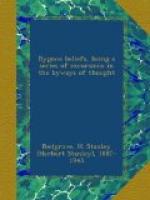[2] EDWARD CLODD: Animism the Seed of Religion (1905), p. 26.
In the first place, something must be said concerning what is called the Doctrine of Emanations, a theory of prime importance in Neo-Platonic and Kabalistic ontology. According to this theory, everything in the universe owes its existence and virtue to an emanation from God, which divine emanation is supposed to descend, step by step (so to speak), through the hierarchies of angels and the stars, down to the things of earth, that which is nearer to the Source containing more of the divine nature than that which is relatively distant. As CORNELIUS AGRIPPA expresses it: “For God, in the first place is the end and beginning of all Virtues; he gives the seal of #the Ideas to his servants, the Intelligences; who as faithful officers, sign all things intrusted to them with an Ideal Virtue; the Heavens and Stars, as instruments, disposing the matter in the mean while for the receiving of those forms which reside in Divine Majesty (as saith Plato in Timeus) and to be conveyed by Stars; and the Giver of Forms distributes them by the ministry of his Intelligences, which he hath set as Rulers and Controllers over his Works, to whom such a power is intrusted to things committed to them that so all Virtues of Stones, Herbs, Metals, and all other things may come from the Intelligences, the Governors. The Form, therefore, and Virtue of things comes first from the Ideas, then from the ruling and governing Intelligences, then from the aspects of the Heavens disposing, and lastly from the tempers of the Elements disposed, answering the influences of the Heavens, by which the Elements themselves are ordered, or disposed. These kinds of operations, therefore, are performed in these inferior things by express forms, and in the Heavens by disposing virtues, in Intelligences by mediating rules, in the Original Cause by Ideas and exemplary forms, all which must of necessity agree in the execution of the effect and virtue of every thing.




